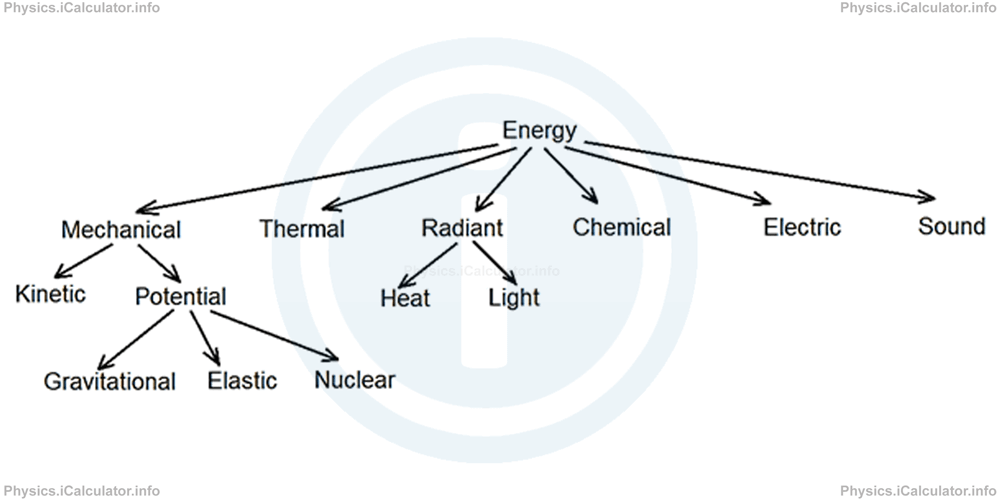Menu
Work and Energy. Types of Energy
Please provide a rating, it takes seconds and helps us to keep this resource free for all to use
In addition to the revision notes for Work and Energy. Types of Energy on this page, you can also access the following Work, Energy and Power learning resources for Work and Energy. Types of Energy
| Tutorial ID | Title | Tutorial | Video Tutorial | Revision Notes | Revision Questions | |
|---|---|---|---|---|---|---|
| 5.2 | Work and Energy. Types of Energy |
In these revision notes for Work and Energy. Types of Energy, we cover the following key points:
- What is Work?
- What is Energy?
- What are the units of Work and Energy?
- How is Energy classified?
- The names of all types of energy you will encounter during your study of Physics
Work and Energy. Types of Energy Revision Notes
In Physics, a system, person or object is doing work if
- A force is exerted on a certain object, and
- The object changes its place due to the action of the given force.
Mathematically, we have:
In symbols,
where:
- F is the force exerted
- Δx is the object's displacement.
Work is a scalar quantity. It is measured in Joules [J]. 1 J = 1 N × m.
In Thermodynamics (especially when dealing with food (chemical) energy and thermal energy, another unit known as Calorie [cal] is often used. The conversion factor between Joule and Calorie is
Not always, the direction of force is in the direction of motion. In this case, we have to use only the component of force that lies in the direction of motion.
In this case, only Fx = F ∙ cos α contributes to the motion. Therefore, the work done by the force F will be
= F × cos α × ∆x
This is still a 1-D motion regardless the fact that the direction of force F is not in the direction of motion. You must consider only the force component that lies in the direction of motion.
When the object is moving in two or three dimensions, we use the equation
= |F| × √(xf - xi )2 + (yf - yi )2 + (zf - zi )2
To calculate the work done by the force F. Here, the expression within the square root represents the displacement r in 3 dimensions.
Geometrically, Work is represented by the area under the Force vs Position graph. This method is particularly useful when the force used is not constant.
Energy E is the ability of an object or system to do work. Therefore, Work is a kind of energy change in a system. We can write
= Einitial - Efinal
Energy is also measured in Joules [J].
Energy is classified in two main groups: I. Energy of state and II. Energy of transfer. The scheme below shows the relationship between the most important types of energy with each other.

Whats next?
Enjoy the "Work and Energy. Types of Energy" revision notes? People who liked the "Work and Energy. Types of Energy" revision notes found the following resources useful:
- Revision Notes Feedback. Helps other - Leave a rating for this revision notes (see below)
- Work, Energy and Power Physics tutorial: Work and Energy. Types of Energy. Read the Work and Energy. Types of Energy physics tutorial and build your physics knowledge of Work, Energy and Power
- Work, Energy and Power Practice Questions: Work and Energy. Types of Energy. Test and improve your knowledge of Work and Energy. Types of Energy with example questins and answers
- Check your calculations for Work, Energy and Power questions with our excellent Work, Energy and Power calculators which contain full equations and calculations clearly displayed line by line. See the Work, Energy and Power Calculators by iCalculator™ below.
- Continuing learning work, energy and power - read our next physics tutorial: Kinetic Energy
Help others Learning Physics just like you
Please provide a rating, it takes seconds and helps us to keep this resource free for all to use
We hope you found this Physics tutorial "Work and Energy. Types of Energy" useful. If you did it would be great if you could spare the time to rate this physics tutorial (simply click on the number of stars that match your assessment of this physics learning aide) and/or share on social media, this helps us identify popular tutorials and calculators and expand our free learning resources to support our users around the world have free access to expand their knowledge of physics and other disciplines.